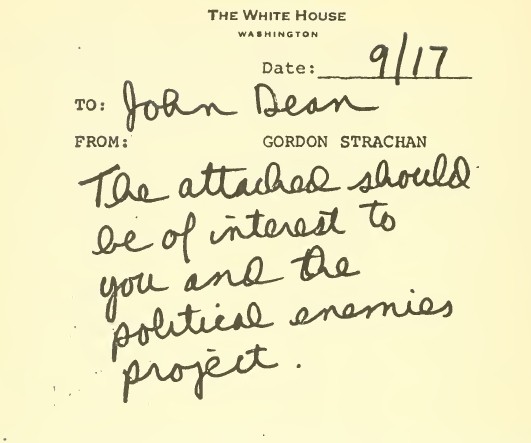
Description
Timeline of Events Related to Nixon’s Enemies List
- June 24, 1971: George T. Bell, assistant to Special Counsel Charles Colson, sends a memo to White House Counsel John Dean titled “OPPONENTS LIST.” This memo contains a list of 20 individuals compiled by Colson, along with reasons for their perceived offense to the Nixon administration and, in some cases, their vulnerabilities.
- August 16, 1971: John Dean sends a memo with the subject line “Dealing with our Political Enemies.” In this memo, Dean states his support for using “the available federal machinery to screw our political enemies.” This indicates the administration’s intent to utilize government resources against their political opponents.
- August 3, 1972: A White House audio recording captures a conversation between President Nixon, John Ehrlichman, and H.R. Haldeman. During this discussion, Nixon expresses frustration about not using the power of the Internal Revenue Service (IRS) against their political enemies. He states, “We have all this power and we aren’t using it, now what the Christ is that,” and suggests the need for individuals who are not “nice guys” to carry out such actions.
- 1971 – 1973 (Ongoing): The “Opponents List,” later known as the “Enemies List,” grows significantly. Starting with 20 names, it expands to include 576 individuals. This expansion encompasses a wide range of people, including supporters and staffers of George McGovern, all black members of Congress, NFL quarterback Joe Namath, and actress Carol Channing.
- June 26, 1973: During a Congressional hearing, John Dean publicly reveals the existence of an “enemies list” maintained by the White House. He mentions a memorandum he requested to prepare “a means to attack the enemies of the White House” and confirms the list was “rather extensive and continually being updated.”
- June 27, 1973: CBS reporter Daniel Schorr, during a live broadcast, obtains and begins reading the original “Enemies List.” It is during this live report that Schorr discovers his own name is on the list, appearing as number 17.
- June 26, 1975: President Richard Nixon provides grand jury testimony as part of the Watergate investigation. Questioned by Special Prosecutor Henry Ruth about potential White House attempts to influence the IRS to harass Lawrence O’Brien, Nixon defends his administration’s tactics. He claims that as a candidate, he was also a victim of abuses of power involving the IRS and FBI and suggests that the current investigation is one-sided, ignoring the actions of his political opponents. He argues that “in politics in America, … some pretty rough tactics are used.”
Cast of Characters
- Richard Nixon: The 37th President of the United States (1969-1974). The creation and use of the Enemies List occurred during his administration. The excerpts reveal his direct interest in utilizing government agencies, particularly the IRS, against his political adversaries.
- John Dean: White House Counsel to President Nixon. He was instrumental in the efforts to target political enemies and acknowledged the existence and purpose of the Enemies List during Congressional hearings, bringing it to public attention.
- Charles Colson: Special Counsel to President Nixon. He is identified as the initial compiler of the “OPPONENTS LIST” in June 1971, which formed the basis of the later, more extensive Enemies List.
- George T. Bell: Assistant to Charles Colson. He sent the initial memo containing the “OPPONENTS LIST” to John Dean.
- H.R. Haldeman: White House Chief of Staff under President Nixon. He is present during the August 3, 1972, White House recording where the use of the IRS against political enemies is discussed with Nixon and Ehrlichman.
- John Ehrlichman: Assistant to the President for Domestic Affairs and Chief Domestic Advisor under President Nixon. He participates in the August 3, 1972, discussion regarding using the IRS against political opponents.
- Daniel Schorr: A prominent journalist and CBS News correspondent. He famously received a copy of the Enemies List and read it live on television, discovering his own name was included.
- George Schultz: (Mentioned as one of two people interviewed in the collection, though the content of his interview is not detailed in the provided excerpts). He served in various cabinet positions under President Nixon, including Secretary of Labor, Director of the Office of Management and Budget, and Secretary of the Treasury.
- Henry Ruth: Watergate Special Prosecutor who questioned Richard Nixon during his grand jury testimony in June 1975 regarding potential abuses of power against political opponents.
- Lawrence O’Brien: A leading Democratic Party electoral strategist. He is mentioned during Nixon’s grand jury testimony as someone the White House may have attempted to target through the IRS.
- Harold J. Gibbons: Vice president of the Teamsters Union. A memo from Charles Colson to John Dean regarding alleged tax discrepancies in Gibbons’ income tax return is included as an exhibit, indicating efforts to use the IRS against him.
- Jack Anderson: A well-known investigative journalist. A memo from Charles Colson to John Dean concerning information received from an informer about Anderson is included, suggesting efforts to gather negative information on him.
- George McGovern: Democratic Party nominee for President in 1972. His campaign staff and supporters were specifically targeted and included on the Enemies List.
- Joe Namath: A prominent NFL quarterback. His inclusion on the Enemies List highlights the broad and sometimes seemingly arbitrary nature of the list.
- Carol Channing: A well-known American actress, singer, dancer, and comedian. Her presence on the Enemies List further illustrates its expansive and diverse nature.
President Richard Nixon’s Enemies List – Documents, White House Recordings and Interviews
177 pages of documents, 14 minutes of Nixon White House recordings, and 2 excerpts of oral history interviews of Daniel Schorr and George Schultz, covering the creation and development of a list of individuals viewed by the Nixon White House as President Nixon’s major political opponents, which came to be known as the “enemies list.”
On June 24, 1971 a memo was sent to White House counsel John Dean from George T. Bell, the assistant to Charles Colson, the special counsel to the White House. The memo’s subject line was “OPPONENTS LIST.” Colson had compiled a list of 20 people, listing why they offended the Administration and in some cases their areas of exposure.
Dean was onboard. In a memo sent out by him on August 16, 1971 with the subject line, “Dealing with our Political Enemies,” he wrote “we can use the available federal machinery to screw our political enemies.”
Over the next couple of years, the list would grow to 576 names. It had grown wide enough to include supporters and staffers of George McGovern, all black members of Congress, NFL quarterback Joe Namath and American actress, singer, dancer and comedian Carol Channing.
On June 27, 1973 the public became aware of the existence of the list when during a Congressional hearing John Dean referred to it. Later that day CBS reporter Daniel Schorr got a copy of the original “Enemies List” during a live broadcast. While reading off the names on the list, it was then and there on live TV that he learned that he was on the list, number 17.
Highlights from this collection include:
White House Nixon Audio Tape Excerpt August 3, 1972 – President Nixon, Ehrlichman, and Haldeman discuss using the IRS against political enemies. Nixon tells Haldeman, “We have all this power and we aren’t using it, now what the Christ is that.” Nixon later says, “There must be something we can do… Anybody who can do this kind of work? I think the problem is we have too many nice guys around, who just want to do the right thing.”
Richard Nixon Grand Jury Testimony Excerpt – Testimony given by Nixon on June 26, 1975. After a series of questions by Watergate Special Prosecutor Henry Ruth about whether the White House attempted to influence the IRS to audit or otherwise harass Lawrence O’Brien, a leading Democratic Party electoral strategist. Nixon makes a break in the questioning and makes a statement to defend his political tactics, to assert that as a candidate he was the victim of abuses of power in which the IRS and the FBI were used against him, and that the current investigation was one sided ignoring the tactics of his opponents. Nixon said, “But I think that it is time, and perhaps the Special Prosecutor, when he files his final report, will have one paragraph in for history, it is time for us to recognize that in politics in America, and this is not excusable, but it does explain it to an extent, particularly where the highest office in the land is involved, and even in some instances where campaigns for governor in major states or senators are involved, that in politics some pretty rough tactics are used.”
Senate Hearing Transcript Excerpt – On June 26, 1973 John Dean reveals the existence of an enemies list. In his testimony Dean says, “I might also add that in my possession is a rather, very much down the line to what you are talking about, is a memorandum that was requested by me to prepare a means to attack the enemies of the White House. There was also maintained what was called an enemies list, which was rather extensive and continually being updated.”
Select Committee On Presidential Campaign Activities Of The United States Senate Exhibits – Exhibits from a Senate Committee Report of documents submitted by John Dean regarding an Enemies List including:
Memorandum for John Dean from Charles Colson re: Tax discrepancies in income tax return of Harold J. Gibbons, vice president of the Teamsters Union.
Memorandum for John Dean from Charles Colson re: Information received from an informer concerning Jack Anderson
Memorandum prepared by John Dean for members of the White House staff. Subject: Dealing with our Political Enemies
Memorandum for John Dean from Charles Colson re: Names given top priority on enemies list
Memorandum for Larry Higby from John Dean concerning names for enemies list
Memorandum from a member of Charles Colson’s staff re: People who attended a rally for a “dump Nixon” program
List of McGovern campaign staff with asterisks beside key names that were to be included in the Opponents Project.
List of Democratic contributors of $25,000 or more in 1968 campaigns.

Related products
-
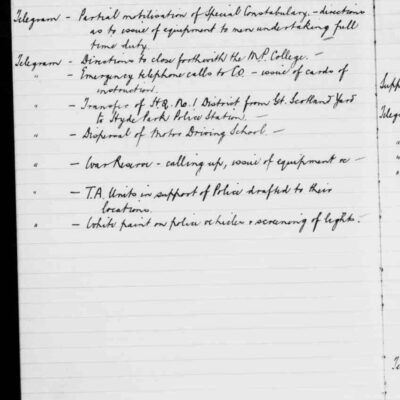
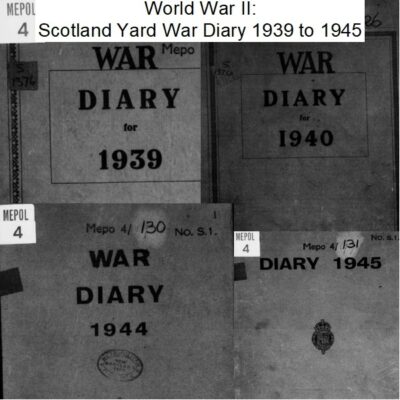
World War II: Scotland Yard War Diary from 1939 to 1945
$3.94 Add to Cart -
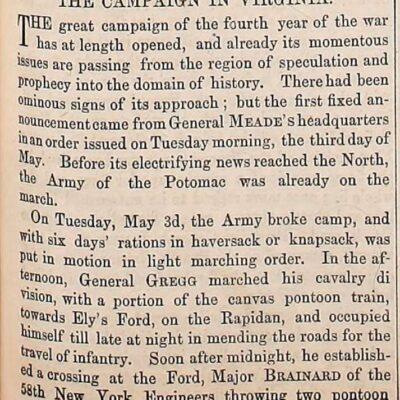
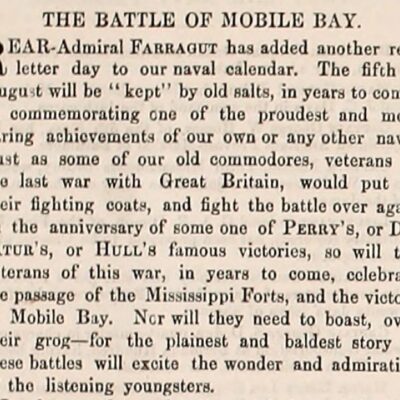
Civil War: Army Navy Journal & Gazette Volume 1 (1863 – 1864)
$19.50 Add to Cart -
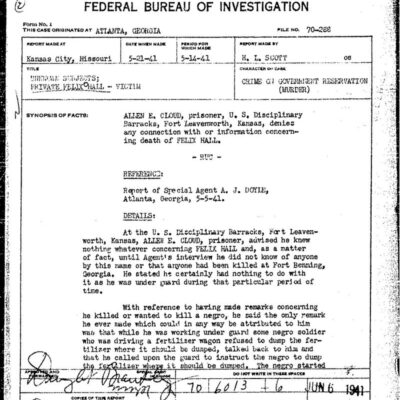
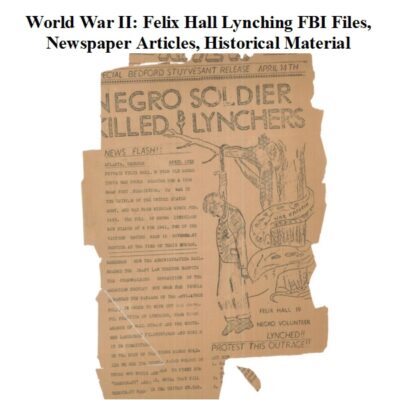
World War II: Felix Hall Lynching – FBI Files, Articles, Historical Records
$9.99 Add to Cart -
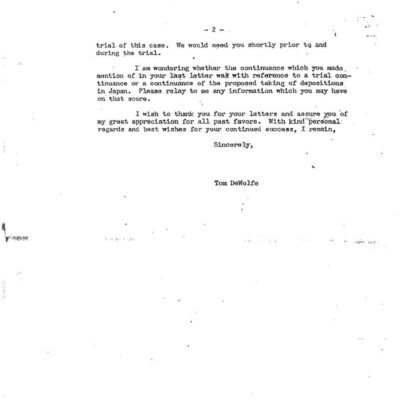
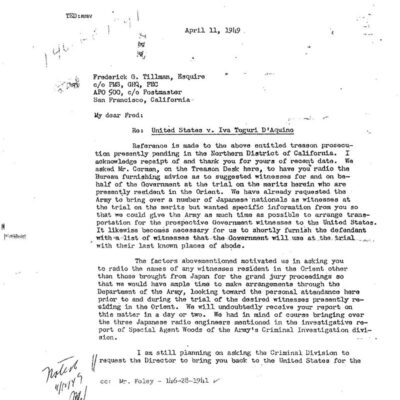
Tokyo Rose: Department of Justice Prosecution Files
$19.50 Add to Cart